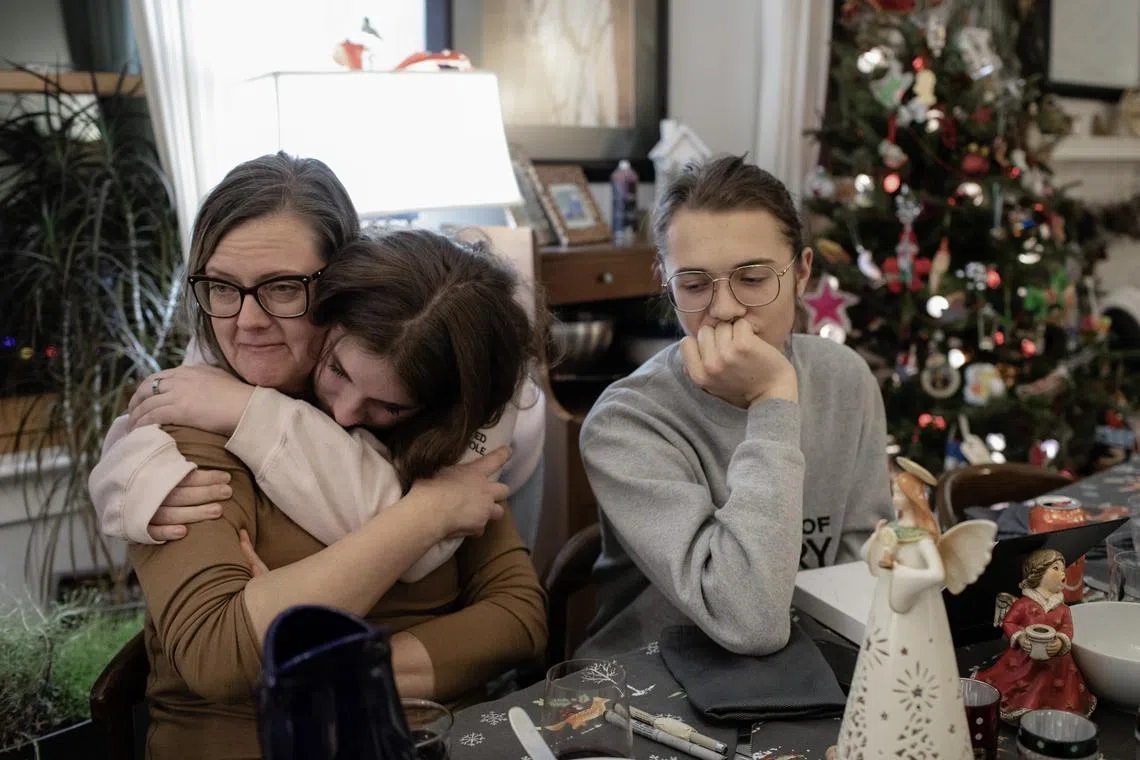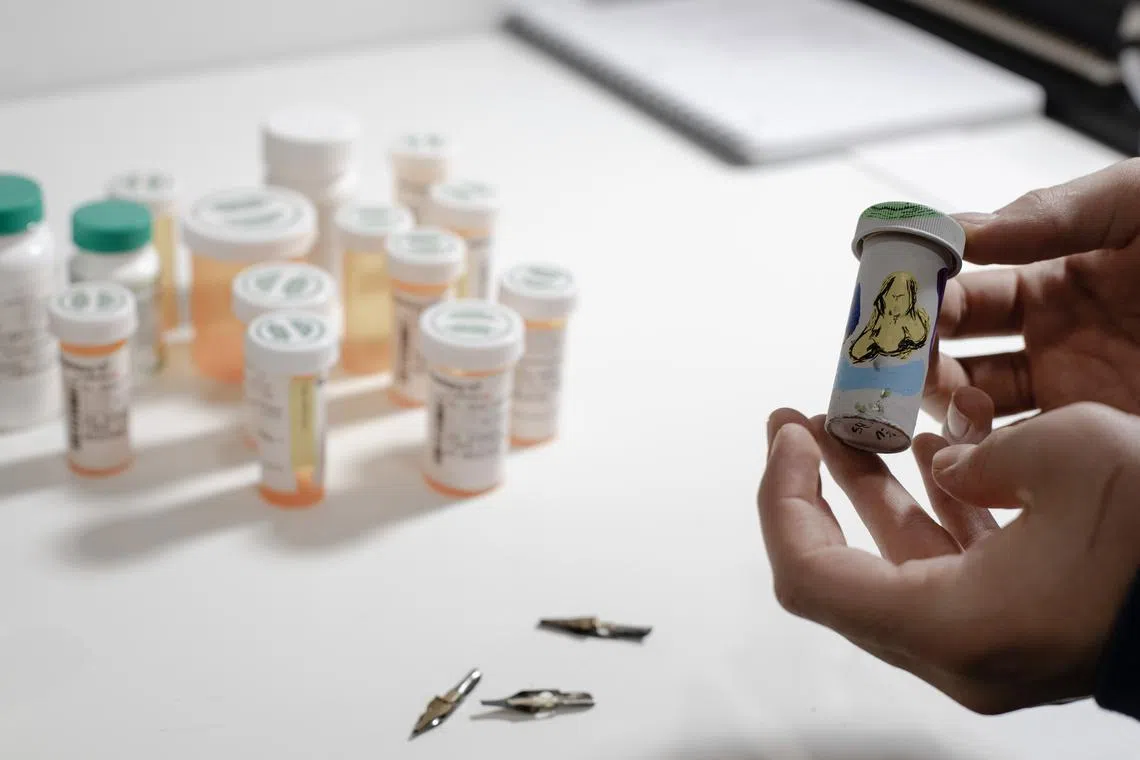‘TikTok Tics’: How teens recovered from the sudden, explosive neurological problem
Sign up now: Get ST's newsletters delivered to your inbox

Aidan developed involuntary tics after watching videos on TikTok posted by teenagers claiming to have Tourette's syndrome.
PHOTO: NYTIMES
Follow topic:
CALGARY – Aidan’s tics erupted one day after school in early 2021, about a month after the long Covi-19 pandemic lockdown had ended.
The 16-year-old convulsed while walking into the house, head snapping and arms swinging, sometimes letting out high-pitched whistles and whoops.
Aidan’s parents looked up from the living room couch with alarm. They had been worried about the teenager’s ratcheting anxiety – related to Covid-19, gender dysphoria, college applications, even hanging out with friends. But they were not prepared for this dramatic display.
“We watched this happen in front of our eyes,” Aidan’s mother Rhonda recalled. “It looked like Aidan was going crazy.”
They rushed Aidan to the emergency room, but doctors found nothing wrong.
After calling a neurologist, the family learned that more than a dozen adolescents in Calgary had recently experienced similar spasms.
Over the next year, doctors around the world treated thousands of young people for sudden, explosive tics.
Many of the patients had watched popular TikTok videos of teenagers claiming to have Tourette syndrome. A spate of alarming headlines about “TikTok tics” followed.
But similar outbreaks have happened for centuries. Mysterious symptoms can spread rapidly in a close-knit community, especially one that has endured a shared stress.
The TikTok tics are one of the largest modern examples of this phenomenon.
They arrived at a unique moment in history, when a once-in-a-century pandemic spurred pervasive anxiety and isolation, and social media was at times the only way to connect and commiserate.
Now, experts are trying to tease apart the many possible factors – internal and external – that made these teenagers so sensitive to what they watched online.

Experts are trying to tease apart the many possible factors that made these teenagers so sensitive to what they watched online.
PHOTO: NYTIMES
Four out of five of the adolescents were diagnosed with a psychiatric disorder, and one-third reported past traumatic experiences, according to a study from the University of Calgary that analysed nearly 300 cases from eight countries.
In new research that has not yet been published, the Canadian team also found a link to gender. The adolescents were overwhelmingly girls, or were transgender or non-binary – though no one knows why.
Perhaps as striking as the wave of TikTok tics is how quickly it has receded.
As teenagers have resumed their pre-pandemic social lives, new cases of the tics have petered out.
And doctors said that most of their tic patients had recovered, illustrating the expansive potential for adolescent resilience.
“Adolescence is a period of rapid social and emotional development,” said Dr Tamara Pringsheim, a neurologist who co-led the studies in Calgary. “They are like sponges, grabbing on to new skills to cope.”
Around the time Aidan started to tic, Dr Pringsheim and Dr Davide Martino, movement specialists at the University of Calgary, saw a message in an online forum for the American Academy of Neurology.
“My practice has seen an unprecedented increase in young adolescent women with what appears to be acute explosive motor and vocal tics,” wrote a doctor in Kansas City, Missouri.
The Canadian neurologists had seen the same thing. Most of these new patients did not fit the mould of a typical case of Tourette syndrome, which generally affects boys and begins in early childhood.
Tourette’s tics tend to be simple movements – like blinking or coughing – and they wax and wane over time.

Aidan’s mother Rhonda (left) had contacted dozens of pediatricians, neurologists and psychiatrists after a trip to the emergency room.
PHOTO: NYTIMES
In contrast, the new patients were often rushed to the emergency room with tics that had appeared seemingly overnight. They were relentless, elaborate movements, often accompanied by emotionally charged insults or funny phrases.
The matching accounts from physicians around the world made the neurologists suspect a shared source.
They searched on YouTube but found little.
Dr Pringsheim’s teenage daughter suggested that they look at TikTok, an app used by more than two-thirds of American teenagers.
When they searched for the word “tic” and hundreds of videos popped up, Dr Pringsheim was stunned.
“This is the person that I saw in my clinic today,” she recalled thinking.
In the months after the frightening trip to the emergency room, Rhonda contacted dozens of paediatricians, neurologists and psychiatrists.
Aidan started on a variety of psychiatric medications – including anti-psychotics – but the drugs came with side effects and seemed to make the tics worse.

Neurologists said that a majority of the adolescents who developed tics during the pandemic have stopped twitching.
PHOTO: NYTIMES
In August 2021, after missing six months of school, Aidan was offered a coveted spot at a small rehabilitation clinic for functional disorders at Alberta Children’s Hospital.
At the heart of the rehabilitation programme was a cognitive-behavioural approach that addressed the psychological root of the problem and helped children develop better ways to cope.
The patients needed to accept two things: that they did not have Tourette syndrome, and that their twitches were partly under their control. They had to want to get better.
For eight to 10 hours a week for six months, Aidan met with a variety of specialists, deleted TikTok and started on anti-depressants.
Shortly after finishing the rehab programme, Aidan returned to school and graduated on time, with honours.
Aidan has not had a tic in a year and no longer uses TikTok.
Neurologists said that a majority of the adolescents who developed tics during the pandemic – even those who did not have intensive treatment like Aidan – have stopped twitching.
Although Aidan’s illness derailed their lives for a year, Rhonda and Aidan said the experience pushed them to grapple with painful family dynamics that long predated the pandemic.
“We’re closer than we were before,” Rhonda said.

